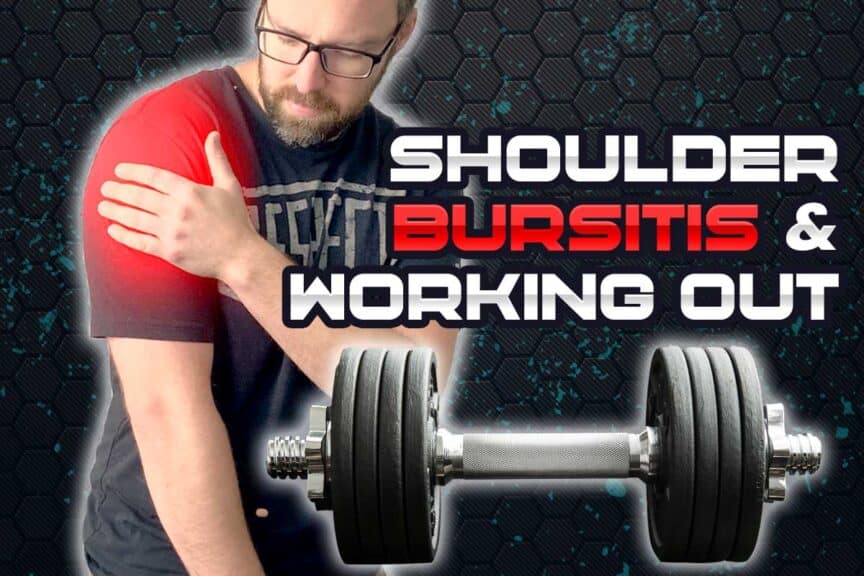Shoulder bursitis is one of the most common areas in the body to get bursitis. As a physical therapist, I treat it constantly within the clinic. Having shoulder bursitis can not only be painful but can also really interfere with physical activities and specific aspects of one’s lifestyle.
If you want to remain physically active and keep working out, but you’re not sure how to do so with shoulder bursitis, this article will give you some critical insight to help you out.
Working out with shoulder bursitis requires avoiding certain shoulder movements and positions while ensuring that you have excellent movement patterns around your shoulder, including proper scapulohumeral rhythm. This can help ensure your subacromial is not continually irritated when moving.
While having shoulder bursitis can prove to be rather annoying and even stubborn at times, there are often plenty of ways to remain physically active and workout as you get the issue under control; you just have to know what to avoid, as movements and positions that continually irritate the bursa will impede any sort of recovery.
If you want to know the exact details and ensure greater outcome success with this condition, then keep on reading!

Disclaimer: While I am a physical therapist, I am not YOUR physical therapist. As a result, I cannot tell you whether or not any treatments or training methodologies mentioned on this website or in this article may or may not be appropriate for you, including for shoulder bursitis. By following any information within this post, you are doing so at your own risk. You are advised to seek appropriate medical advice for any pain you may be experiencing.
Related content:
The basics of bursas & bursitis
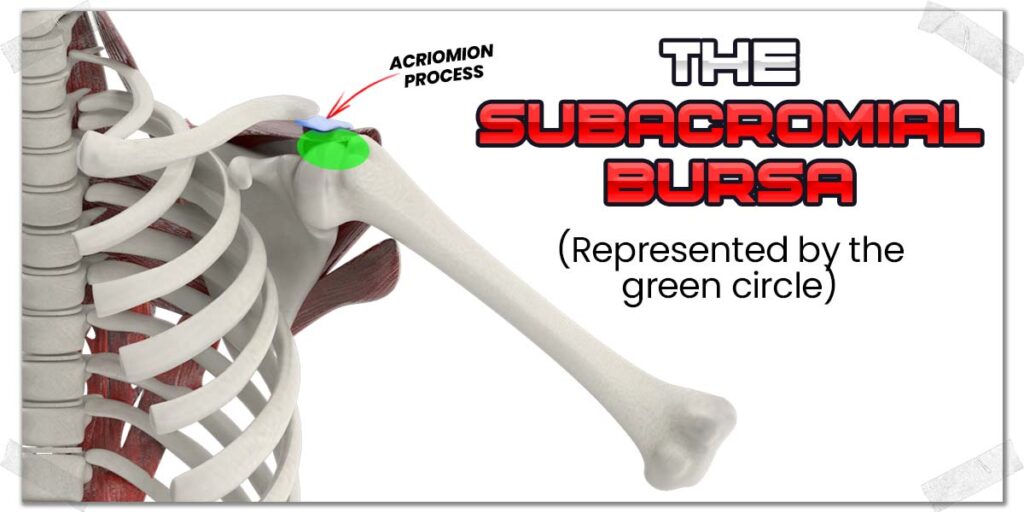
Anatomical image: Envato Elements
With so many tendons and tissues crossing over bony & lumpy surfaces within our body, it’s a wonder that these structures in our body move and glide as well as they do when we produce physical movement.
This smooth, gliding movement is achieved largely in part by bursa pads. A bursa is a small, water balloon-like disc that sits within areas where tendons or other structures constantly glide and move underneath our skin. The primary role of these bursa discs is to decrease friction that would otherwise be uncomfortable and irritating for the structures that are constantly moving on top of our bones.
For the record, the human body is filled with hundreds of these bursa pads.
But while a bursa helps decrease friction and irritation for other tissues, sometimes the bursa itself can become irritated, inflamed and painful. When this condition occurs, it is known as bursitis, which is characteristically marked with pain and discomfort arising from the bursa when we produce physical movement.
Why shoulder bursitis is so common
There are a number of bursa pads around the shoulder, but the most commonly affected bursa (by an absolute landslide) is the subacromial bursa. This bursa pad sits underneath the roof of the shoulder blade (known as the acromion process) and on top of the head of the humerus (the upper arm bone).
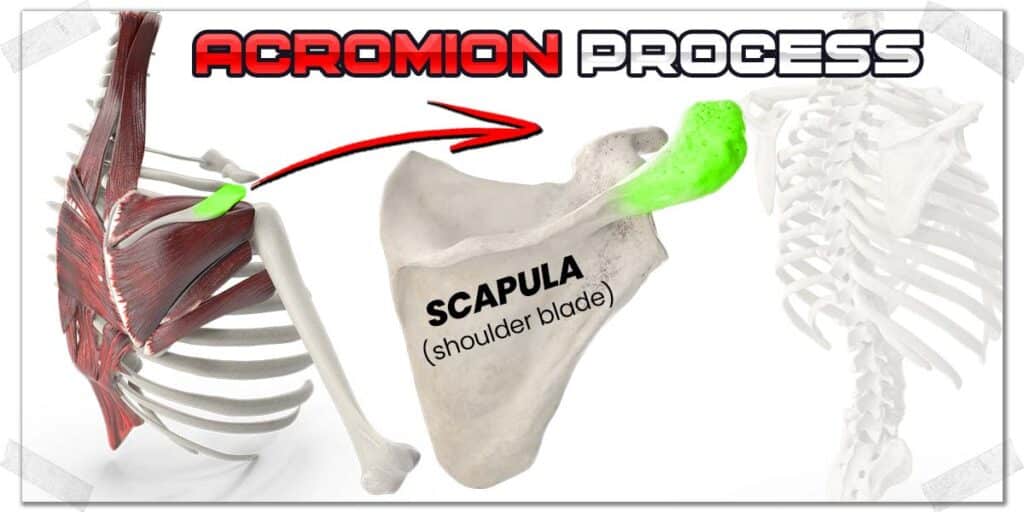
“From birth, no one teaches us how to move our arms; our brain just figures out a pattern and goes with it. Sometimes it learns a pattern that is far less than ideal, which can predispose us to shoulder issues such as bursitis.”
The less common reason for shoulder bursitis
Sometimes the acromion process is shaped in a way that has a bit of a downward hook to it, which can push into the bursa pad whenever we move our arm upwards. The greater the extent of this “hooking” of the acromion, the greater the likelihood this hook will irritate the bursa pad with various arm movements.
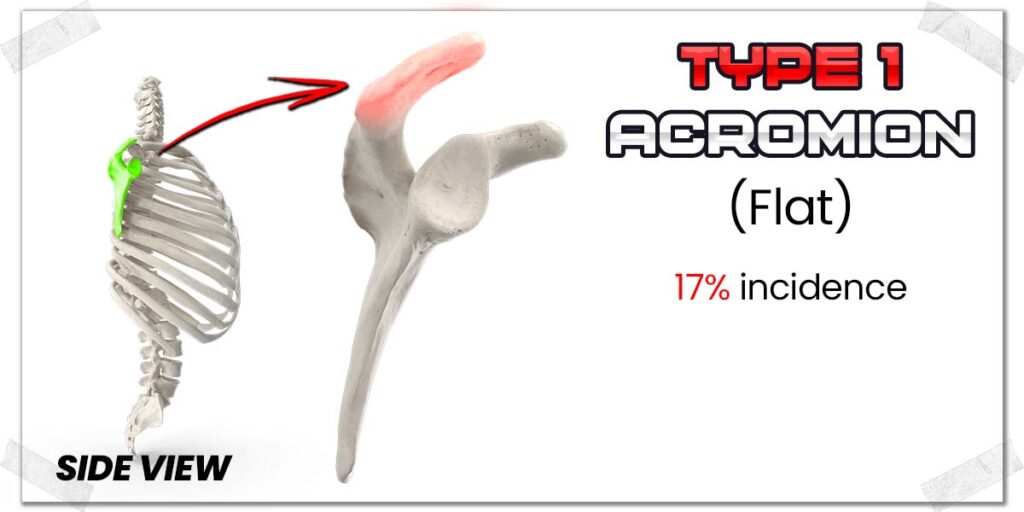
Anatomical image: Envato Elements
There’s nothing you can do about a hooked acromion other than make sure your shoulder blade mechanics are absolutely on point (discussed later in the article) when producing movement and exercising.
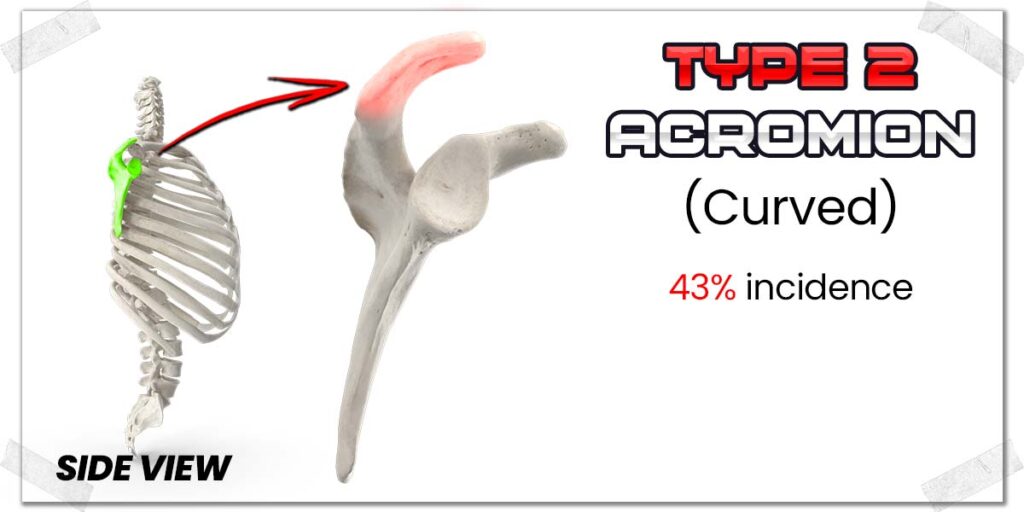
Anatomical image: Envato Elements
If you have a seriously hooked acromion (classified as a type III acromion), there are minor surgical procedures where the bone can be shaved down as a means to reduce the bony hook.
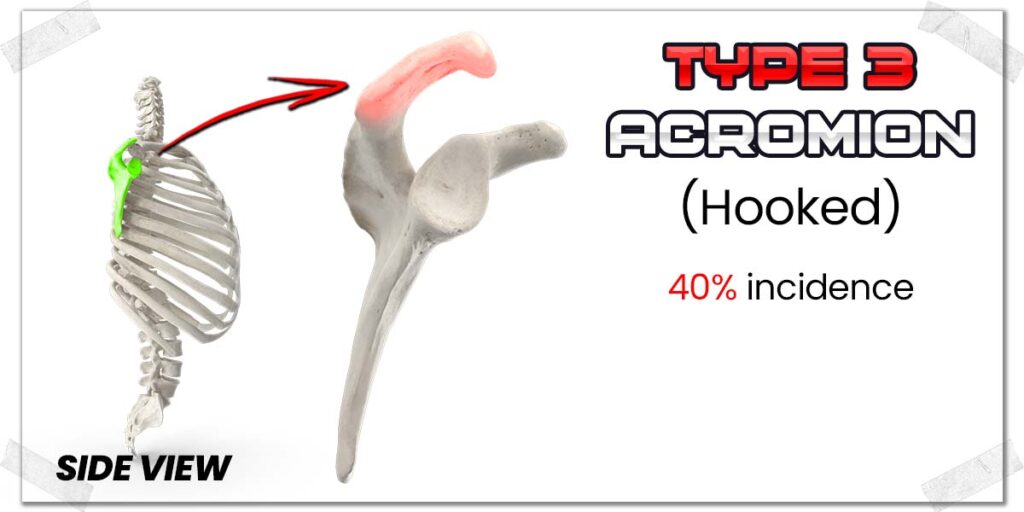
Anatomical image: Envato Elements
Thankfully, most people don’t have a severely hooked acromion; rather, their bursa gets irritated for other reasons, such as poor movement mechanics, which can typically be corrected.
The more common reason why most people get shoulder bursitis
Physical irritation of the subacromial bursa often results from improper movement execution between the shoulder blade and the humerus bone. When certain arm movements are executed in a less-than-ideal manner, it becomes very easy to slam the head of the humerus into the roof of the shoulder blade, directly pinching and irritating the bursa pad each time this occurs. It can also create another painful, debilitating shoulder condition known as shoulder impingement.
Since bursas can’t really be directly treated with exercise (as opposed to an unhealthy muscle or tendon), it’s extremely important to focus on movements that should be avoided during your workouts and physical activity pursuits.Click to PostFrom birth, no one teaches us how to move our arms; our brain just figures out a pattern and goes with it. Sometimes it learns a pattern that is far less than ideal, which can predispose us to shoulder issues such as bursitis.
When performing specific movements of the shoulder, the shoulder blade and the humerus should have certain ratios of movement, in which they both move at certain rates relative to one another. This is known as scapulohumeral rhythm (scapulo = shoulder blade, humeral =upper arm bone, rhythm = timing).
Since bursas can’t really be directly treated with exercise (as opposed to an unhealthy muscle or tendon), it’s extremely important to focus on movements that should be avoided during your workouts and physical activity pursuits.
The greater the range of motion with specific movements (discussed in the next section), the more important it is for your shoulder to produce an adequate scapulohumeral rhythm. If this rhythm is not achieved, each movement will only serve to further irritate the subacromial bursa, making it more difficult to get the pain under control and letting the bursa recover and become healthy again.
So, now that you know the very basics of shoulder bursitis, let’s talk in more detail about what you’ll want to avoid with your workouts and physical activities while you work on letting the bursa cool off and become healthy again.
The one thing you MUST stop doing for all exercises
There are a number of movements and positions to avoid when dealing with shoulder bursitis. However, if you want to keep your upper body active and moving while you work on getting your shoulder bursa healthy again, it would be prudent of you to avoid a common, dogmatic belief system regarding the position you should keep your shoulders in when performing exercises.
The whole idea of holding your shoulders “down and back” while performing exercises—despite what you may have been told—is horrid advice for just about anyone.
Now, I’m not one to step up on soapboxes on my blog, but this “advice” is soapbox-worthy. Any knowledgeable healthcare professional or respectable personal trainer will likely attest that this is the worst position you could hold your shoulders in when performing any sort of arm-dominant exercise, especially overhead exercises.
How keeping the shoulders retracted and depressed makes bursitis worse
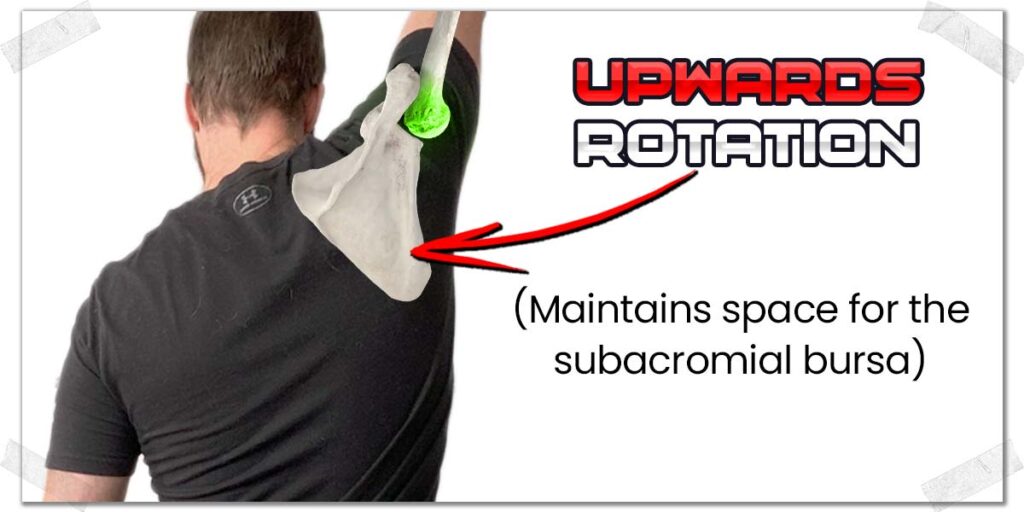
If you’re trying to hold your shoulder blades back and down while performing arm movements such as overhead presses, reaching overhead, or even raising your arms out to your side, you’re creating the perfect environment to make your bursitis worse. By holding your shoulder blade in place while moving your arm, you are producing the worst scapulohumeral rhythm possible.
If your shoulder blades stay pulled down and back while lifting your arms, you’ll be slamming the head of the humerus (upper arm bone) into the roof of the shoulder blade (acromion), pinching the bursa and continually irritating it as a result. This is especially likely if you have a type III acromion.
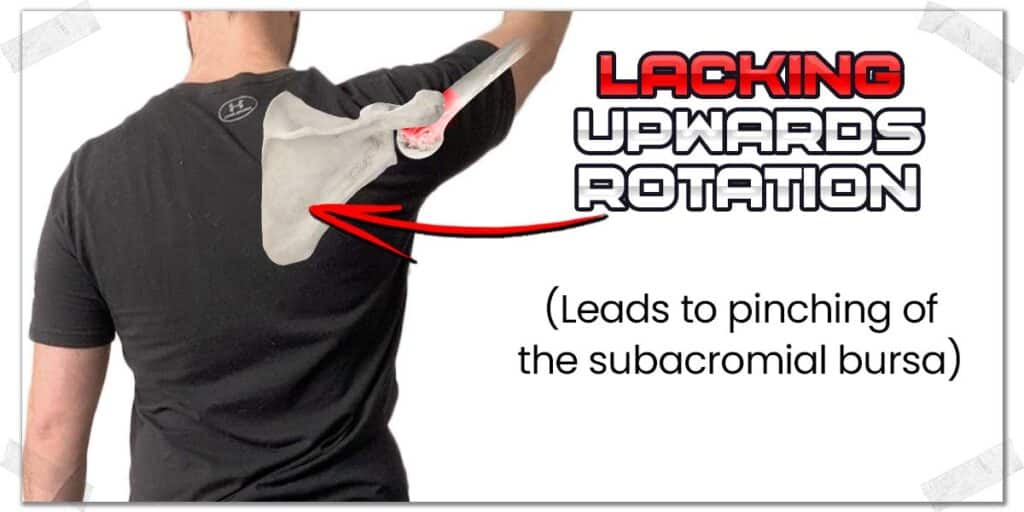
Instead, your shoulder blade should be in a neutral position when starting any arm movement. From there, as your arm lifts upwards, your shoulder blade should swing upwards as well, as this will allow the roof of the shoulder blade to move upwards so as not to make contact with the upper arm bone.
If you learn how to do this properly, you may very well be on your way to eliminating the underlying cause of your shoulder bursitis.
Take a look at the following video for a powerful visual demonstration of how moving the shoulder blade upwards is necessary for keeping your shoulder healthy:
Movements to avoid when working out
Since bursas can’t really be directly treated with exercise (as opposed to an unhealthy muscle or tendon), it’s extremely important to focus on movements that should be avoided during your workouts and physical activity pursuits.
Avoiding certain movements for the time being (while you practice restoring your scapulohumeral movement control) will allow your bursa to avoid being continually irritated, which will give it the ability to settle down and become less painful.
You will likely need to avoid any movements that involve raising your arms past 90 degrees in any motion. The more the arm moves upwards at this point, the greater the likelihood that the bursa will be irritated, assuming your scapular positioning and scapulohumeral rhythm are less than ideal.
The movements here to be aware of are shoulder abduction (raising your arm out to your side) and shoulder flexion (raising your arm directly in front of you). Raising the arm in either direction—particularly past 90 degrees—could lead to irritation of the bursa, depending on the nature of your shoulder mechanics and how inflamed your bursa is. So, be mindful of these movements and consider keeping your arm below parallel with the floor for the time being.
Don’t worry; this is not a forever thing. (Injuries are common, and while they can hamper your motivation, there are ways to keep your spirits high as you work through your bursitis.) Avoiding such movements, for the time being, will create a healthier environment for your bursa. As the bursa gets healthier and you improve your scapulohumeral rhythm, you’ll be able to return to these movements with a significantly reduced risk of bursitis reoccurring.
Common gym-based and exercise movements you may want to avoid include:
- Direct overhead presses and motions (of any kind) such as military presses, push-presses, push jerks, snatches (of any variety)
- Vertical rowing exercises, such as lat pull downs (since the arms tend to go up above the head).
- Shoulder work that involves raising the arm out to the side at ranges around 90 degrees
- Overhead movements while seated or lying down (French curls, dumbbell or barbell pullovers, etc.)
- Heavy carrying loads that pull the arm & shoulder blade down (such as heavy farmer’s carries). This may or may not irritate your shoulder, so play around with it if need be to see if it should be avoided.
Movements that you can likely still do
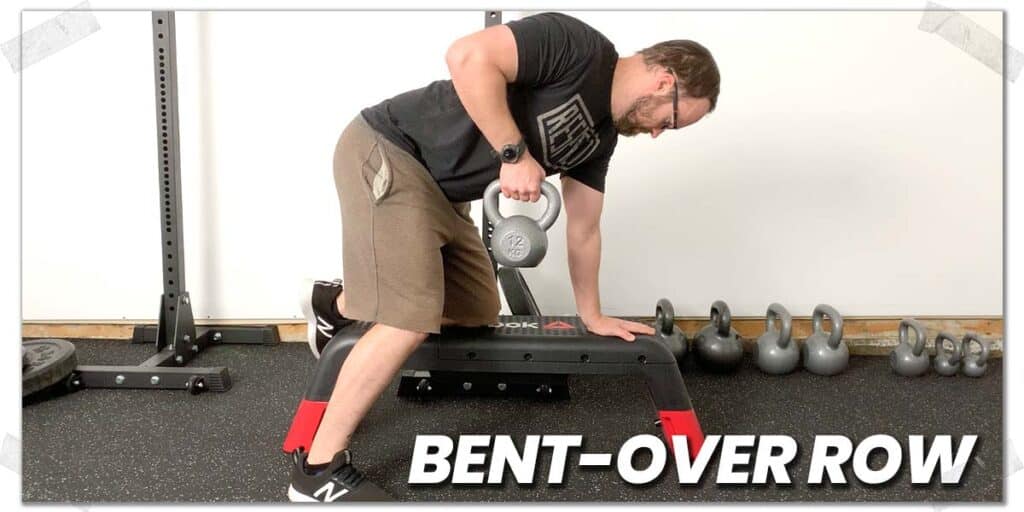
If you’re feeling restricted after reading the preceding section about what you can’t do, relax; there is still a world of movements and exercises that you can likely do.
You’ll need to play around with each one to see how it affects your shoulder and makes it feel, but the following exercises and movements are still entirely possible to perform without irritating your bursa.
As a general rule: If your pain is absent & doesn’t show up or worsen during the activity or later on after the session, then it’s likely just fine to do. If your symptoms worsen during or after your session, avoid the activity or exercise for the time being and try a similar movement or exercise. It can be a bit of trial and error, but it’s certainly worth it.
Movements that are likely still ok for you to do:
- Any horizontal (in relation to your body) pushing movements (bench press, push-ups, etc.)
- Any horizontal pulling movements (cable rows, TRX rows, etc.)
- Any arm pushing or pulling movements that keep the shoulder from lifting up to 90 degrees (bicep curls, tricep press downs, etc.)
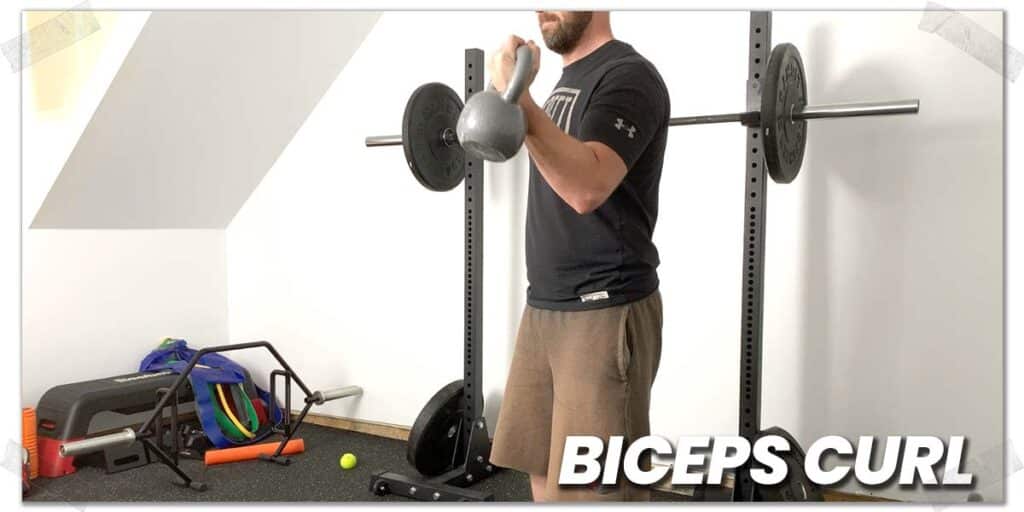
Bonus: Understanding the nature of cortisone injections
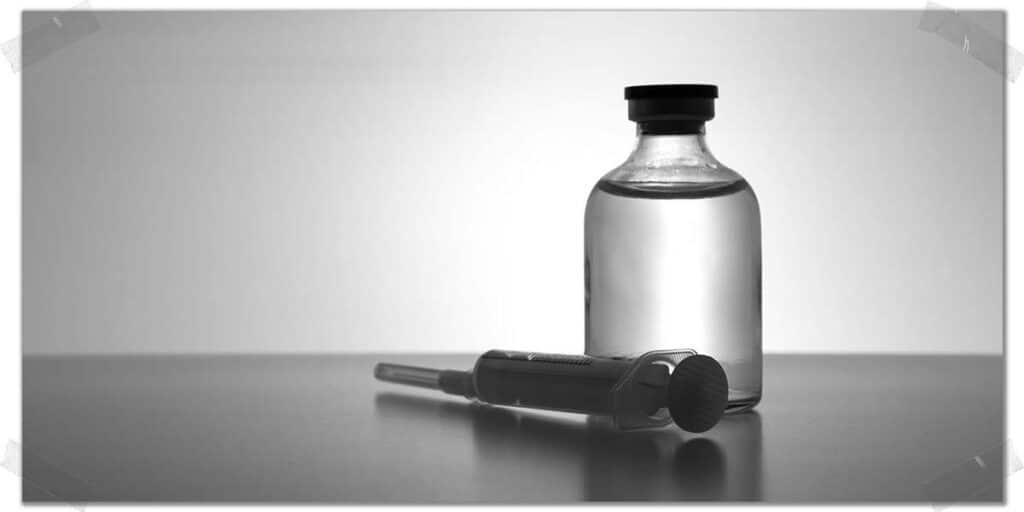
While bursas can recover and improve through rest and other conservative measures (such as physical therapy), sometimes they’re stubborn and unhealthy enough to the point that they need additional treatment.
When this situation arises, a steroid injection into the bursa is typically the first treatment option. The purpose of this intervention is to drastically reduce the amount of inflammation (which causes pain) within the bursa.
This is typically done under ultrasound guidance by a medical practitioner. The steroid injection given is usually a mixture of a local numbing agent (such as lignocaine) combined with a corticosteroid (such as hydrocortisone, methylprednisolone, etc.)
These corticosteroids are very powerful anti-inflammatory drugs and can offer significant pain relief for cases of subacromial (shoulder) bursitis.1–4
While these injections certainly have a time and a place, it’s important to know that they are best utilized in combination with other treatments (such as continuing with physical therapy, avoiding painful or irritating arm movements, etc.).
I have had numerous patients over the years benefit significantly from these subacromial injections, typically after progress isn’t being made with traditional conservative measures.
If you are curious about whether or not you could benefit from a cortisone injection, it’s best to talk with your doctor.
As one last tip: A single steroid injection into a body part (such as the subacromial bursa) typically presents no long-term risks; however, repeated steroid injections into the same body part can lead to long-term issues by compromising the health of the injected tissue, so avoiding multiple injections into a single area is likely a smart move.
Final thoughts
Shoulder bursitis can be rather annoying and even frustrating to deal with; however, if you know the basics of how and why it has occurred to you, there’s a good likelihood that you can continue to workout and remain physically active. That is, of course, so long as you know which shoulder movements, positions and exercises you should avoid for the time being.
If you keep producing movements and exercises that keep irritating your bursa, it’ll be next to impossible for the issue to resolve on its own. But by knowing how to train around this stubborn issue rather than through it, you can keep yourself active while letting it heal.
And by knowing how to properly move your shoulder with certain movements, you’ll be at a greatly decreased risk for your shoulder bursitis returning in the future!
References:

Hi! I’m Jim Wittstrom, PT, DPT, CSCS, Pn1.
I am a physical therapist who is passionate about all things pertaining to strength & conditioning, human movement, injury prevention and rehabilitation. I created StrengthResurgence.com in order to help others become stronger and healthier. I also love helping aspiring students and therapists fulfill their dreams of becoming successful in school and within their clinical PT practice. Thanks for checking out my site!

